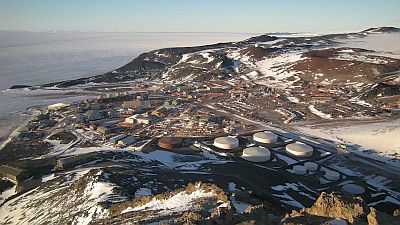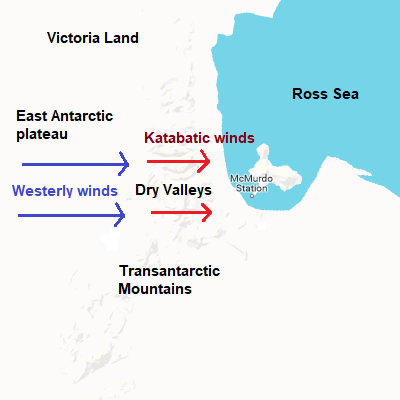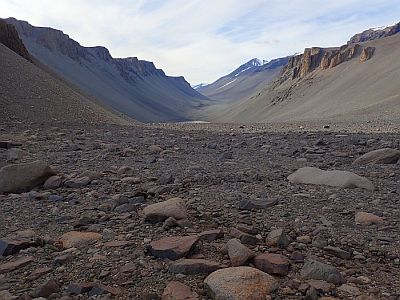Select units of measurement for the temperature and rainfall tables (metric or imperial).
Average weather, temperature, rainfall, sunshine hours
At McMurdo Station, a permanent Antarctic base founded by the Usa in 1956, there is a
polar climate, with average temperatures below freezing all year round. However, in summer, in December and January, highs are close to freezing, and in the last twenty years they have slightly exceeded this value. The highest records are around 10 °C (50 °F).
The closest country is New Zealand, and the Scott Base, belonging to New Zealand, is located about 2 kilometers (1.2 miles) away.
McMurdo Station is currently the largest Antarctic base. We are on the coast of the
Ross Sea, one of the two large bays, together with the Weddell Sea, where the ocean penetrates the continent the most, approaching the South Pole, which is about 1,300 km (805 mi) away.
The latitude of McMurdo station, almost 78 degrees south, is similar to that of Vostok station, which holds the coldest world record, however, the climate of McMurdo is much milder, given that the station is located on the coast and practically at sea level.
In reality, McMurdo is located on the Hut Point peninsula, i.e. the southern part of
Ross Island, the southernmost Antarctic island reachable by sea. The island is volcanic and culminates with
Mount Erebus, 3,794 meters (12,447 feet) high, the second highest volcano in Antarctica after Mount Sidley.
The island seems to be part of the continent because, in the southern part, it is connected to the Antarctic ice sheet by the
Ross Ice Shelf, the largest ice shelf in Antarctica, whereas in the western part, where the McMurdo Sound is located, and in the northern part, overlooking the ocean, the sea ice melts in summer.

At McMurdo, the
average temperature drops below -20 °C (-4 °F) from April to September, with a minimum in August, the coldest month, of -25.5 °C (-14 °F).
The cold record is -50.6 °C (-59.1 °F), although the temperature rarely drops below -40 °C (-40 °F). In August 2023, the temperature dropped to -48 °C (-54.5 °F), the highest it had been for years, and the average for the month was -31.4 °C (-24.5 °F), the lowest since August 1978.
In the only two summer months, December and January, the average temperature rises to -2.5 °C (27.5 °F).
Here are the average temperatures.
McMurdo - Average temperatures (2000-2020) |
| Month | Min | Max | Mean |
|---|
| January | -5.2 | 0.4 | -2.4 |
|---|
| February | -11.6 | -5.4 | -8.5 |
|---|
| March | -20.7 | -13.6 | -17.2 |
|---|
| April | -25.2 | -17.5 | -21.4 |
|---|
| May | -25.9 | -17.5 | -21.7 |
|---|
| June | -27.5 | -18.9 | -23.2 |
|---|
| July | -29.9 | -21.1 | -25.5 |
|---|
| August | -30 | -21.1 | -25.6 |
|---|
| September | -27.7 | -18.7 | -23.2 |
|---|
| October | -20.9 | -13.2 | -17 |
|---|
| November | -11.6 | -5.1 | -8.4 |
|---|
| December | -5.1 | 0.3 | -2.4 |
|---|
| Year | -20.1 | -12.6 | -16.35 |
|---|
is scarce, just 215 millimeters (8.5 in) per year, and almost all occurs in the form of
snow or sleet. Snowfall is frequent but generally light. On average, there are 184 days with snow or sleet per year (for a total of 148 cm or 58.5 inches of total accumulated snow), but only 46 days in which this precipitation exceeds 1 millimeter.
Here is the average precipitation.
McMurdo - Average precipitation| Month | Days |
|---|
| January | 15 | 3 |
|---|
| February | 30 | 5 |
|---|
| March | 15 | 3 |
|---|
| April | 20 | 4 |
|---|
| May | 20 | 6 |
|---|
| June | 30 | 6 |
|---|
| July | 15 | 5 |
|---|
| August | 13 | 4 |
|---|
| September | 10 | 3 |
|---|
| October | 20 | 3 |
|---|
| November | 12 | 2 |
|---|
| December | 14 | 2 |
|---|
| Year | 215 | 46 |
|---|
At McMurdo Station the
polar night, in which the sun never rises, lasts about four months, and goes from April 25th to August 17th. It must be said that for a few weeks, at the beginning and at the end of this period, the sun approaches the horizon around midday (or rather around 2 in the afternoon given the time zone adopted), providing some light.
The
polar day, in which the sun never sets, also lasts four months, and runs from October 24th to February 20th. For a few weeks, before and after this period, the sun remains close to the horizon even at midnight, providing some light, so the so-called "white nights" occur.
At the summer solstice, December 21st or 22nd, at midday the sun reaches 35 and a half degrees above the horizon, that is, 12 degrees higher than at the South Pole.
The average wind at McMurdo Station is 22 kph (13.5 mph), while the strongest gusts have exceeded 185 kph (115 mph).
To the west of the station, beyond the McMurdo Sound, we find the
Transantarctic Mountains, a long mountain range of more than 2,000 km (1,200 mi) that almost reaches the South Pole. To the west of the mountains we find the East Antarctic plateau, the ice cap, which in this area is approximately 2,300 meters (7,500 ft) high.
The McMurdo dry valleys
Since the winds on the plateau normally come from the west, the area at the foot of the mountains, even more than McMurdo Station, is often hit by
katabatic, or downslope, winds, which become hotter and drier as they move downwards.
 McMurdo dry valleys, map with explanation
McMurdo dry valleys, map with explanation
It is the area where the phenomenon, once considered inexplicable, of the
dry valleys occurs, the main ones being the Victoria valley, the Wright valley and the Taylor valley. Here the climate is so arid (precipitation is less than 100 millimeters or 4 inches per year) and the winds are so strong and frequent (and therefore capable of carrying away the snow) and dry (so as to increase snow evaporation, or rather, sublimation), that the valleys themselves are free from ice. Added to this is the sun, whose rays heat the dark rock, melting the little snow that has accumulated on the ground.

This is the area of Earth where conditions are most similar to those of the planet Mars (i.e., a cold and windy desert, with rocky soil and not covered in snow), so probes are tested here and then sent to explore the "red planet".
In this area there are some
lakes, such as Lake Brownworth and Lake Vanda, which are fed by the Wright Glacier, which melts in the short summer, giving life to the
Onyx River.
Since we are in an endorheic basin (the Onyx river has no outlet to the sea), which receives large quantities of mineral salts from nearby glaciers, the lakes are salty, or rather hypersaline. Due to the very high salinity, the surface pond called
Lake Don Juan, one of the most saline bodies of water in the world, is in a liquid state even in winter, despite the fact that the water temperature is much lower than the freezing point.
Lake Vanda is instead covered by a 3.5/4 meter layer of ice, which partially melts on the surface in late December. At depth (the lake is up to 75 meters or 245 feet deep), not only is the lake in a liquid state, but the water temperature even reaches 23 °C (73.5 °F). In the lower layer, heat remains trapped because the water is saltier and therefore denser, and does not mix with the upper layers.
In the
Vanda station, located near the lake and closed in 1995, in January 1974 the highest temperature ever in the part of Antarctica south of the polar circle was recorded, namely 14.5 °C (58 °F): this gives us an indication of the mild microclimate of these valleys.